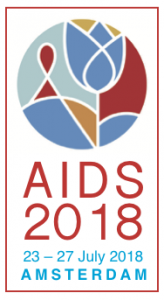Dolutegravir monotherapy: still no longer recommended in either research or clinical practice
24 August 2018. Related: Conference reports, Treatment strategies, World AIDS 14 Barcelona 2002.
Although in 2015 several research groups reported promising early results from small studies using dolutegravir (DTG), these studies were generally stopped due to the unpredictability of viral rebound in some participants. The cases involved a high likelihood of cross-class integrase inhibitor drug resistance. [1, 2]
This led to universal recommendations in treatment guidelines in 2016 (UK, US, EACS) against further research into the use of dolutegravir monotherapy.
It was therefore disconcerting to have two oral presentations at AIDS 2018 reporting studies that still continued after these guidelines recommendations, one of which plans to continue follow-up out to four years.
The first was a French switch study called MONCAY, presented by Laurent Hocqueloux from the Regional Hospital of Orléans, which included an analysis of virological failures on dolutegravir monotherapy, that rightly led to the study being stopped, but long after other studies should have already alerted researchers to this danger. [3]
MONCAY randomised 158 virally suppressed participants on DTG/3TC/abacavir to either switch to dolutegravir monotherapy or remain on triple-drug ART. Baseline demographics (in the monotherapy arm) included median CD4 nadir of 309 cells/mm3, current CD4 843 cells/mm3, time since diagnosis 9.5 years, median time on ART 8.1 years and use of four previous ART combinations. No IQR or range was provided for these figures.
Five participants using dolutegravir monotherapy had virological failure: two at the week 24 primary endpoint, two at week 36 and one at week 48. Two of these later cases included development of integrase inhibitor mutations. This study started in December 2015 and the DSMB recommended changes in December 2017.
A second study that is worryingly still ongoing was presented by Dominique Laurent Braun from University Hospital Zurich as an oral presentation in the same programme session. [4]
This is an open-label non-inferiority design, that randomised (2:1) 101 participants who were diagnosed within six months of likely HIV infection, to either dolutegravir monotherapy (n=68) or standard triple-drug ART (n=33). Participants had to have been suppressed on ART for >48 weeks. The study started in November 2015 and continued to enrol until March 2017.
Baseline characteristics overall included median age 42 (IQR: 33 to 47, 97% male, 3-6 years (IQR: 1.9 to 8.0) on ART before the study and median CD4 nadir 358 cells/mm3 (IQR: 265 to 486).
One participant in the dolutegravir monotherapy group experienced viral failure at week 36 (with viral load at 382 copies/mL) and two participants in the cART group left the study before the week 48 primary endpoint, because they moved to another country. All remaining participants reported viral load <50 copies/mL at week 48.
Results from a CSF substudy (lumber puncture samples were taken at baseline and week 48; n=23 monotherapy and n=14 triple therapy) were detectable, but at <40 copies/mL, with no difference between the mono and triple therapy groups.
The case of virological failure resuppressed <50 copies/mL after switching back to triple therapy, without development of drug-related resistance. The failure of treatment however, was explained by the researchers as being a protocol violation, due to later discover that primary HIV infection had been incorrectly diagnosed, and that this participant was diagnosed in 2004 as a late presenter.
It was disconcerting when the presenter concluded that dolutegravir monotherapy was an effective and safe option due to showing statistical non-inferiority, with the main concern being accurate diagnosis of acute infection (see comment below).
comment
These two presentations generated many audience comments and questions, many focused on the risks for these participants. These are also included on the conference webcasts.
Although one study is now closed (questionably late), it is a concern to hear that ethical consent has been provided for the Swiss study to continue follow-up using monotherapy for up to four years.
This group justified continuing their study because early HIV infection is associated with a smaller reservoir. However, the case of viral failure did not have the highest reservoir, measured by total HIV DNA. Although median reservoir size is lower in acute infection, the range of value commonly show some people having significantly higher HIV DNA levels in acute infection than others have in chronic infection.
Another comment, included the point that non-inferiority studies should now have tighter margins for viral failure, using new FDA recommendation of –4% for the confidence interval (rather than previous use of –10% or –12%).
References
- Collins S. Remarkable results with dolutegravir monotherapy. HTB, December 2015.
https://i-base.info/htb/29154 - Collins S. Simplifying HIV treatment: dual therapy works but monotherapy with either boosted-PIs or dolutegravir does not. HTB, November 2016.
https://i-base.info/htb/30918 - Hocqueloux L et al Dolutegravir monotherapy versus dolutegravir/abacavir/lamivudine for HIV-1-positive virologically suppressed patients: Results from the randomized non-inferiority MONCAY trial. AIDS 2018, 23-27 July 2018, Amsterdam. Oral abstract TUAB0103.
http://programme.aids2018.org/Abstract/Abstract/1387 (abstract and slides)
https://youtu.be/pgmb1Fi63Fo?t=1793 (webcast) - Braun LR et al. Simplification to dolutegravir monotherapy is non-inferior compared to continuation of combination antiretroviral therapy in patients who initiated combination antiretroviral therapy during primary HIV infection: A randomized, controlled, non-inferiority trial. AIDS 2018, 23-27 July 2018, Amsterdam. Oral abstract TUAB0102.
http://programme.aids2018.org/Abstract/Abstract/2894 (abstract and slides)
https://youtu.be/pgmb1Fi63Fo?t=829 (webcast)


 Simon Collins, HIV i-Base
Simon Collins, HIV i-Base